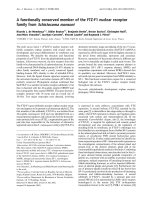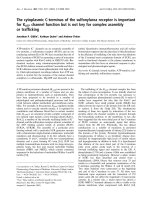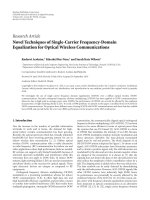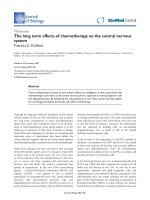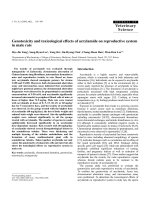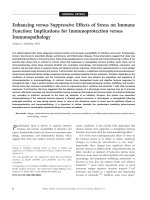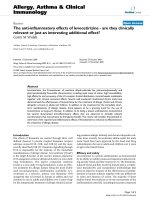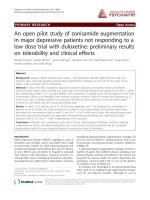Báo cáo y học: "Enhancing versus Suppressive Effects of Stress on Immune Function: Implications for Immunoprotection versus Immunopathology" doc
Bạn đang xem bản rút gọn của tài liệu. Xem và tải ngay bản đầy đủ của tài liệu tại đây (186.06 KB, 10 trang )
ORIGINAL ARTICLE
Enhancing versus Suppressive Effects of Stress on Immune
Function: Implications for Immunoprotection versus
Immunopathology
Firdaus S. Dhabhar, PhD
It is widely believed that stress suppresses immune function and increases susceptibility to infections and cancer. Paradoxically,
stress is also known to exacerbate allergic, autoimmune, and inflammatory diseases. These observations suggest that stress may
have bidirectional effects on immune function, being immunosuppressive in some instances and immunoenhancing in others. It has
recently been shown that in contrast to chronic stress that suppresses or dysregulates immune function, acute stress can be
immunoenhancing. Acute stress enhances dendritic cell, neutrophil, macrophage, and lymphocyte trafficking, maturation, and
function and has been shown to augment innate and adaptive immune responses. Acute stress experienced prior to novel antigen
exposure enhances innate immunity and memory T-cell formation and results in a significant and long-lasting immunoenhancement.
Acute stress experienced during antigen reexposure enhances secondary/adaptive immune responses. Therefore, depending on the
conditions of immune activation and the immunizing antigen, acute stress may enhance the acquisition and expression of
immunoprotection or immunopathology. In contrast, chronic stress dysregulates innate and adaptive immune responses by
changing the type 1–type 2 cytokine balance and suppresses immunity by decreasing leukocyte numbers, trafficking, and function.
Chronic stress also increases susceptibility to skin cancer by suppressing type 1 cytokines and protective T cells while increasing
suppressor T-cell function. We have suggested that the adaptive purpose of a physiologic stress response may be to promote
survival, with stress hormones and neurotransmitters serving as beacons that prepare the immune system for potential challenges
(eg, wounding or infection) perceived by the brain (eg, detection of an attacker). However, this system may exacerbate
immunopathology if the enhanced immune response is directed against innocuous or self-antigens or dysregulated following
prolonged activation, as seen during chronic stress. In view of the ubiquitous nature of stress and its significant effects on
immunoprotection and immunopathology, it is important to further elucidate the mechanisms mediating stress-immune
interactions and to meaningfully translate findings from bench to bedside.
Key words: allergy, catecholamines, glucocorticoid/cortisol, immune surveillance, proinflammatory/autoimmune, psycho-neuro-
immunology, vaccine
P
sychological stress is known to suppress immune
function and increase susceptibility to infections and
cancer. Paradoxically, stress is also known to exacerbate some
allergic, autoimmune, and inflammatory diseases, which
suggests that stress may enhance immune function under
certain conditions. It has recently been appreciated that
whereas chronic stress suppresses or dysregulates immune
function, acute stress often has immunoenhancing effects.
1
One of the most underappreciated effects of stress on
the immune system is its ability to induce significant
changes in leukocyte distribution in the body.
2
Importantly, these changes have significant effects on
immune function in different body compartments that are
either enriched or depleted of leukocytes during stress.
Moreover, acute stress can affect dendritic cell, neutrophil,
macrophage, and lymphocyte trafficking, maturation, or
function in ways that can enhance innate and adaptive
immunity.
3–6
Acute stress experienced prior to novel
cutaneous antigen exposure increases memory T-cell
formation and results in a significant and long-lasting
increase in immunity.
3,4,6
Similarly, acute stress experi-
Firdaus S. Dhabhar: Stanford Center on Stress & Health and
Department of Psychiatry & Behavioral Sciences, Stanford University,
Stanford, CA.
The work described here was supported by grants from the National
Institutes of Health (AI48995 and CA107498) and The Dana
Foundation.
Correspondence to: Dr. Firdaus S. Dhabhar, Stanford Center on Stress &
Health, Stanford University, 1201 Welch Road, MSLS Building, P114,
Stanford, CA 94305-5485; e-mail:
DOI 10.2310/7480.2008.00001
2 Allergy, Asthma, and Clinical Immunology, Vol 4, No 1 (Spring), 2008: pp 2–11
enced during antigen reexposure enhances secondary
immune responses.
7
This suggests that depending on the
condition under which the immune response is initiated,
stress can enhance the acquisition and expression of
immunoprotection and immunopathology.
In contrast to acute stress, chronic stress suppresses or
dysregulates innate and adaptive immune responses
through mechanisms that involve suppression of leukocyte
numbers, trafficking, and function or changes in the type
1–type 2 cytokine balance.
8,9
Chronic stress has recently
been shown to increase susceptibility to skin cancer by
suppressing type 1 cytokines and protective T cells while
increasing suppressor T-cell function.
10
We have suggested that the primary biologic purpose of a
psychophysiological stress response may be to promote
survival, with stress hormones and neurotransmitters serving
as beacons that prepare the immune system for potential
challenges (eg, wounding or infection) perceived by the brain
(eg, detection of an imminent attack).
1,2
However, this same
system may exacerbate immunopathology if the enhanced
immune response is directed against innocuous or self-
antigens or if the stress response system is overactivated, as
seenduringchronicstress.Inviewoftheubiquitousnatureof
stress and its significant effects on immunoprotection and
immunopathology, it is important to further elucidate the
mechanisms mediating stress-immune interactions and to
translate findings from bench to bedside.
Stress
Although the word stress generally has negative connota-
tions, stress is a familiar aspect of life, being a stimulant for
some but a burden for others. Numerous definitions have
been proposed for the word stress. Each definition focuses
on aspects of an internal or external challenge, disturbance,
or stimulus; on perception of a stimulus by an organism; or
on a physiologic response of the organism to the
stimulus.
11–13
Physical stressors have been defined as
external challenges to homeostasis and psychological
stressors as the ‘‘anticipation justified or not, that a
challenge to homeostasis looms.’’
14
An integrated definition
states that stress is a constellation of events, consisting of a
stimulus (stressor) that precipitates a reaction in the brain
(stress perception) that activates physiologic fight or flight
systems in the body (stress response).
15
The physiologic
stress response results in the release of neurotransmitters
and hormones that serve as the brain’s alarm signals to the
body. It is often overlooked that a stress response has
salubrious adaptive effects in the short run,
1,3
although
stress can be harmful when it is long-lasting.
8,13,16,17
An important distinguishing characteristic of stress is
its duration and intensity. Thus, acute stress has been
defined as stress that lasts for a period of minutes to hours
and chronic stress as stress that persists for several hours per
day for weeks or months.
15
The intensity of stress may be
gauged by the peak levels of stress hormones, neurotrans-
mitters, and other physiologic changes, such as increases in
heart rate and blood pressure, and by the amount of time
for which these changes persist during stress and following
the cessation of stress.
It is important to bear in mind that significant
individual differences exist in the manner and extent to
which stress is perceived, processed, and coped with.
1
These differences become particularly relevant while
studying human subjects because stress perception,
processing, and coping mechanisms can have significant
effects on the kinetics and peak levels of circulating stress
hormones and on the duration for which these hormone
levels are elevated. The magnitude and duration of
catecholamine and glucocorticoid hormone exposure, in
turn, can have significant effects on leukocyte distribution
and function.
18–20
Stress-Induced Changes in Immune Cell
Distribution
Effective immunoprotection requires rapid recruitment of
leukocytes into sites of surgery, wounding, infection, or
vaccination. Immune cells circulate continuously on
surveillance pathways that take them from the blood,
through various organs, and back into the blood. This
circulation is essential for the maintenance of an effective
immune defense network.
21
The numbers and proportions
of leukocytes in the blood provide an important
representation of the state of distribution of leukocytes
in the body and of the state of activation of the immune
system. The ability of acute stress to induce changes in
leukocyte distribution within different body compartments
is perhaps one of the most underappreciated effects of
stress and stress hormones on the immune system.
2
Numerous studies have shown that stress and stress
hormones induce significant changes in absolute numbers
and relative proportions of leukocytes in the blood. In fact,
changes in blood leukocyte numbers were used as a
measure of stress before methods were available to directly
assay the hormone.
22
Studies have also shown that
glucocorticoid
23–25
and catecholamine hormones
26–31
induce rapid and significant changes in leukocyte dis-
tribution and that these hormones are the major mediators
of the effects of stress. Stress-induced changes in blood
Dhabhar, Enhancing versus Suppressive Effects of Stress on Immune Function 3
leukocyte numbers have been reported in fish,
32
ham-
sters,
33
mice,
34
rats,
2,25,35,36
rabbits,
37
horses,
38
nonhuman
primates,
39
and humans.
29,40–43
This suggests that the
phenomenon of stress-induced leukocyte redistribution
has a long evolutionary lineage and that it has important
functional significance.
Studies in rodents have shown that stress-induced
changes in blood leukocyte numbers are characterized by
a significant decrease in the numbers and percentages of
lymphocytes and monocytes and by an increase in the
numbers and percentages of neutrophils.
2,35
Flow cyto-
metric analyses revealed that absolute numbers of peripheral
blood T cells, B cells, natural killer (NK) cells, and
monocytes all show a rapid and significant decrease (40 to
70% lower than baseline) during stress.
2
Moreover, it has
been shown that stress-induced changes in leukocyte
numbers are rapidly reversed on the cessation of stress.
2
In apparent contrast to animal studies, human studies have
shown that stress can increase rather than decrease blood
leukocyte numbers.
11,43–46
This apparent contradiction may
be resolved by taking the following factors into considera-
tion: First, stress-induced increases in blood leukocyte
numbers are observed following stress conditions that
primarily result in the activation of the sympathetic nervous
system. These stressors are often of a short duration (few
minutes) or relatively mild (eg, public speaking).
11,44–46
Second, the increase in total leukocyte numbers may be
accounted for by stress- or catecholamine-induced increases
in granulocytes and NK cells.
8,41,44–46
Third, stress- or
pharmacologically induced increases in glucocorticoid
hormones induce a significant decrease in blood lympho-
cyte and monocyte numbers.
1,25,41,47
Thus, stress conditions
that result in a significant and sustained activation of the
hypothalamic-pituitary-adrenal (HPA) axis result in a
decrease in blood leukocyte numbers.
In view of the above discussion, it has been proposed
that acute stress induces an initial increase followed by a
decrease in blood leukocyte numbers. Stress conditions
that result in activation of the sympathetic nervous system,
especially conditions that induce high levels of norepi-
nephrine, may induce an increase in circulating leukocyte
numbers. These conditions may occur during the begin-
ning of a stress response, very short-duration stress (order
of minutes), mild psychological stress, or exercise. In
contrast, stress conditions that result in the activation of
the HPA axis induce a decrease in circulating leukocyte
numbers. These conditions often occur during the later
stages of a stress response, long-duration acute stressors
(order of hours), or severe psychological, physical, or
physiologic stress. An elegant and interesting example in
support of this hypothesis comes from Schedlowski and
colleagues, who measured changes in blood T-cell and NK
cell numbers as well as plasma catecholamine and cortisol
levels in parachutists.
41
Measurements were made 2 hours
before, immediately after, and 1 hour after the jump. The
results showed a significant increase in T-cell and NK cell
numbers immediately (minutes) after the jump that was
followed by a significant decrease 1 hour after the jump.
An early increase in plasma catecholamines preceded early
increases in lymphocyte numbers, whereas the more
delayed rise in plasma cortisol preceded the late decrease
in lymphocyte numbers.
41
Importantly, changes in NK cell
activity and antibody-dependent cell-mediated cytotoxi-
city closely paralleled changes in blood NK cell numbers,
thus suggesting that changes in leukocyte numbers may be
an important mediator of apparent changes in leukocyte
‘‘activity.’’ Similarly, Rinner and colleagues showed that a
short stressor (1-minute handling) induced an increase in
mitogen-induced proliferation of T and B cells obtained
from peripheral blood, whereas a longer stressor (2-hour
immobilization) induced a decrease in the same prolif-
erative responses.
48
In another example, Manuck and
colleagues showed that acute psychological stress induced a
significant increase in blood cytotoxic T lymphocyte
numbers only in those subjects who showed heightened
catecholamine and cardiovascular reactions to stress.
49
Thus, an acute stress response may induce biphasic
changes in blood leukocyte numbers. Soon after the
beginning of stress (order of minutes) or during mild acute
stress or exercise, catecholamine hormones and neurotrans-
mitters induce the body’s ‘‘soldiers’’ (leukocytes) to exit their
‘‘barracks’’ (spleen, lung, marginatedpool,andotherorgans)
and enter the ‘‘boulevards’’ (blood vessels and lymphatics).
This results in an increase in blood leukocyte numbers, the
effect being most prominent for NK cells and granulocytes.
As the stress response continues, activation of the HPA axis
results in the release of glucocorticoid hormones, which
induce leukocytes to exit the blood and take position at
potential ‘‘battle stations’’ (such as the skin, lung, gastro-
intestinal and urinary-genital tracts, mucosal surfaces, and
lymph nodes) in preparation for immune challenges, which
may be imposed by the actions of the stressor.
2,7,18
Such a
redistribution of leukocytes results in a decrease in blood
leukocyte numbers. Thus, acute stress may result in a
redistribution of leukocytes from the barracks, through the
boulevards, and to potential battle stations within the body.
Since the blood is the most accessible and commonly
used compartment for human studies, it is important to
carefully evaluate how changes in blood immune para-
meters might reflect in vivo immune function in the
4 Allergy, Asthma, and Clinical Immunology, Volume 4, Number 1, 2008
context of the specific experiments or study at hand.
Moreover, since most blood collection procedures involve
a certain amount of stress, since all patients or subjects will
have experienced acute and chronic stress, and since many
studies of psychophysiologic effects on immune function
focus on stress, the effects of stress on blood leukocyte
distribution become a factor of considerable importance.
Dhabhar and colleagues were the first to propose that
stress-induced changes in blood leukocyte distribution
may represent an adaptive response.
35,50
They suggested
that acute stress-induced changes in blood leukocyte
numbers represent a redistribution of leukocytes from
the blood to organs such as the skin, draining sentinel
lymph nodes, and other compartments.
7,18
They hypothe-
sized that such a leukocyte redistribution may enhance
immune function in compartments to which immune cells
traffic during stress. In agreement with this hypothesis, it
was demonstrated that a stress-induced redistribution of
leukocytes from the blood to the skin is accompanied by a
significant enhancement of skin immunity.
7,50,51
Functional Consequences of Stress-Induced Changes
in Immune Cell Distribution
When interpreting data showing stress-induced changes in
functional assays such as lymphocyte proliferation or NK
activity, it may be important to bear in mind the effects of
stress on the leukocyte composition of the compartment in
which an immune parameter is being measured. For
example, it has been shown that acute stress induces a
redistribution of leukocytes from the blood to the skin and
that this redistribution is accompanied by a significant
enhancement of skin cell–mediated immunity.
3,7
In what
might at first glance appear to be contradicting results,
acute stress has been shown to suppress splenic and
peripheral blood responses to T-cell mitogens
52
and
splenic immunoglobulin M (IgM) production.
53
However, it is important to note that in contrast to the
skin that is enriched in leukocytes during acute stress,
peripheral blood and spleen are relatively depleted of
leukocytes during acute stress.
54
This stress-induced
decrease in blood and spleen leukocyte numbers may
contribute to the acute stress–induced suppression of
immune function in these compartments.
Moreover, in contrast to acute stress, chronic stress has
been shown to suppress skin cell–mediated immunity, and
a chronic stress–induced suppression of blood leukocyte
redistribution is thought to be one of the factors mediating
the immunosuppressive effect of chronic stress.
15
Again, in
what might appear to be contradicting results, chronic
stress has been shown to enhance mitogen-induced
proliferation of splenocytes
55
and splenic IgM produc-
tion.
53
However, the spleen is relatively enriched in T cells
during chronic glucocorticoid administration, suggesting
that it may also be relatively enriched in T cells during
chronic stress,
56
and this increase in spleen leukocyte
numbers may contribute to the chronic stress–induced
enhancement of immune parameters measured in the
spleen.
It is also important to bear in mind that the
heterogeneity of the stress-induced changes in leukocyte
distribution
2
suggests that using equal numbers of
leukocytes in a functional assay may not account for
stress-induced changes in relative percentages of different
leukocyte subpopulations in the cell suspension being
assayed. For example, samples that have been equalized for
absolute numbers of total blood leukocytes from control
versus stressed animals may still contain different numbers
of specific leukocyte subpopulations (eg, T cells, B cells, or
NK cells). Such changes in leukocyte composition may
contribute to the effects of stress even in functional assays
using equalized numbers of leukocytes from different
treatment groups. Therefore, stress may affect immune
function at a cellular level (eg, phagocytosis, antigen
presentation, killing, antibody production) and/or through
leukocyte redistribution that could increase or decrease the
number of cells with a specific functional capacity in the
compartment being studied.
Effects of Acute Stress on Leukocyte Trafficking to a
Site of Surgery or Immune Activation
Viswanathan and colleagues used a clinically relevant
subcutaneously implanted surgical sponge model to
elucidate the effects of stress on the kinetics, magnitude,
subpopulation, and chemoattractant specificity of leuko-
cyte trafficking to a site of immune activation or surgery.
5
Mice that were acutely stressed before subcutaneous
implantation of the surgical sponge showed a two- to
threefold higher neutrophil, macrophage, NK cell, and T-
cell infiltration than nonstressed animals. Leukocyte
infiltration was evident as early as 6 hours and peaked
between 24 and 48 hours. Importantly, at 72 hours,
sponges from nonstressed and acutely stressed mice had
comparable and significantly lower leukocyte numbers,
indicating effective resolution of inflammation in both
groups. These authors also examined the effects of stress
on early (6 hours) leukocyte infiltration in response to a
predominantly proinflammatory cytokine, tumour necro-
sis factor-a (TNF-a), and lymphocyte-specific chemokine,
Dhabhar, Enhancing versus Suppressive Effects of Stress on Immune Function 5
lymphotactin (LTN). Acute stress significantly increased
infiltration of macrophages in response to saline, LTN, or
TNF-a; neutrophils only in response to TNF-a; and NK
and T cells only in response to LTN. These results showed
that acute stress significantly enhances the kinetics and
magnitude of leukocyte infiltration into a site of immune
activation or surgery in a subpopulation and chemoat-
tractant-specific manner, with tissue damage or antigen-
or pathogen-driven chemoattractants synergizing with
acute stress to further determine the specific subpopula-
tions that are recruited.
5
Thus, depending on the primary
chemoattractants driving an immune response, acute stress
may selectively mobilize specific leukocyte subpopulations
into sites of surgery, wounding, or inflammation. Such a
stress-induced increase in leukocyte trafficking may be an
important mechanism by which acute stressors alter the
course of different (innate versus adaptive, early versus
late, acute versus chronic) protective or pathologic
immune responses.
Acute Stress–Induced Enhancement of Innate/
Primary Immune Responses
In view of the skin being one of the target organs to which
leukocytes traffic during stress, studies were conducted to
examine whether skin immunity is enhanced when
immune activation/antigen exposure occurs following a
stressful experience. Studies showed that acute stress
experienced at the time of novel or primary antigen
exposure results in a significant enhancement of the
ensuing skin immune response.
3
Compared with controls,
mice restrained for 2.5 hours before primary immuniza-
tion with keyhole limpet hemocyanin (KLH) showed a
significantly enhanced immune response when reexposed
to KLH 9 months later. This immunoenhancement was
mediated by an increase in the numbers of memory and
effector helper T cells in sentinel lymph nodes at the time
of primary immunization. Further analyses showed that
the early stress-induced increase in T-cell memory may
have stimulated the robust increase in infiltrating lym-
phocyte and macrophage numbers observed months later
at a novel site of antigen reexposure. Enhanced leukocyte
infiltration was driven by increased levels of the type 1
cytokines interleukin (IL)-2, interferon (IFN)-c, and TNF-
a, observed at the site of antigen reexposure in animals
that had been stressed at the time of primary immuniza-
tion. Given the importance of inducing long-lasting
increases in immunologic memory during vaccination, it
has been suggested that the neuroendocrine stress response
is nature’s adjuvant, which could be psychologically and/or
pharmacologically manipulated to safely increase vaccine
efficacy.
In a series of elegant experiments, Saint Mezard and
colleagues similarly showed that acute stress experienced at
the time of sensitization resulted in a significant increase in
the contact hypersensitivity (CHS) response.
6
These
investigators showed that acute stress experienced during
sensitization enhanced dendritic cell migration from skin
to sentinel lymph nodes and also enhanced priming of
lymph node CD8
+
T cells. These CD8
+
T cells responded in
greater numbers at the site of antigen reexposure during
the recall phase of the CHS response. These studies also
suggested that the effects of acute stress in this case were
mediated primarily by norepinephrine.
6
Viswanathan and colleagues further elucidated the
molecular and cellular mediators of the immunoenhancing
effects of acute stress.
57
They showed that compared with
nonstressed mice, acutely stressed animals showed sig-
nificantly greater pinna swelling, leukocyte infiltration, and
upregulated macrophage chemoattractant protein 1
(MCP-1), macrophage inflammatory protein 3a (MIP-
3a), IL-1a, IL-1b, IL-6, TNF-a, and IFN-c gene expression
at the site of primary antigen exposure. Stressed animals
also showed enhanced maturation and trafficking of
dendritic cells from skin to lymph nodes, higher numbers
of activated macrophages in skin and lymph nodes,
increased T-cell activation in lymph nodes, and enhanced
recruitment of surveillance T cells to skin. These findings
showed that important interactive components of innate
(dendritic cells and macrophages) and adaptive (surveil-
lance T cells) immunity are mediators of the stress-
induced enhancement of a primary immune response.
Such immunoenhancement during primary immunization
may induce a long-term increase in immunologic memory,
resulting in subsequent augmentation of the immune
response during secondary antigen exposure.
In addition to elucidating mechanisms that could be
targeted to reduce stress-induced exacerbation of allergic,
autoimmune, and proinflammatory reactions, the above-
mentioned studies provide further support for the idea
that a psychophysiologic stress response is nature’s
fundamental survival mechanism that could be therapeu-
tically harnessed to augment immune function during
vaccination, wound healing, or infection.
Acute Stress–Induced Enhancement of Adaptive/
Secondary Immune Responses
Studies have shown that in addition to enhancing primary
cutaneous immune responses, acute stress experienced at
6 Allergy, Asthma, and Clinical Immunology, Volume 4, Number 1, 2008
the time of antigen reexposure can also enhance secondary
or recall responses in skin.
7
Compared with nonstressed
controls, mice that were acutely stressed at the time of
antigen reexposure showed a significantly larger number of
infiltrating leukocytes at the site of the immune reaction.
These results demonstrated that a relatively mild beha-
vioural manipulation can enhance an important class of
immune responses that mediate harmful (allergic derma-
titis) and beneficial (resistance to certain viruses, bacteria,
and tumours) aspects of immune function.
Blecha and colleagues reported a similar stress-
induced enhancement of CHS reactions in mice,
58
and
Flint and colleagues showed that acute stress enhanced
CHS responses in both male and female mice and that
immunoenhancement was partially dependent on gluco-
corticoid hormones.
59
Stress-induced enhancement of the
elicitation phase of skin cell–mediated immunity has also
been reported in hamsters.
33
Taken together, studies
show that acute stress can significantly enhance the
immunization/sensitization/induction, as well as the
reexposure/elicitation/recall phases of skin cell-mediated
immunity.
Hormone and Cytokine Mediators of Stress-Induced
Enhancement of Immune Function
Although much work remains to be done to identify
molecular, cellular, and physiologic mechanisms mediat-
ing the adjuvant-like, immunoenhancing effects of acute
stress, several studies have begun to identify endocrine and
immune mediators of these effects. Studies have shown
that corticosterone and epinephrine are important med-
iators of an acute stress–induced immunoenhancement.
50
Adrenalectomy, which eliminates the glucocorticoid and
epinephrine stress response, eliminated the stress-induced
enhancement of skin delayed-type hypersensitivity (DTH).
Low-dose corticosterone or epinephrine administration
significantly enhanced skin DTH.
50
In contrast, high-dose
corticosterone, chronic corticosterone, or low-dose dex-
amethasone administration significantly suppressed skin
DTH. These results suggested a novel role for adrenal stress
hormones as endogenous immunoenhancing agents. They
also showed that stress hormones released during a
circumscribed or acute stress response may help prepare
the immune system for potential challenges (eg, wounding
or infection), for which stress perception by the brain may
serve as an early warning signal. Studies by Flint and
colleagues have also suggested that corticosterone is a
mediator of the stress-induced enhancement of skin
CHS,
59
whereas Saint-Mezard and colleagues have sug-
gested that the adjuvant-like effects of stress on dendritic
cell and CD8
+
T-cell migration and function are mediated
by norepinephrine.
6
Studies have also examined the immunologic media-
tors of an acute stress–induced enhancement of skin
immunity. Since IFN-c is a critical cytokine mediator of
cell-mediated immunity and delayed as well as contact
hypersensitivity, studies were conducted to examine its
role as a local mediator of the stress-induced enhance-
ment of skin DTH.
51
The effect of acute stress on skin
DTH was examined in wild-type and IFN-c receptor
gene knockout mice (IFN-cR
2/2
) that had been sensitized
with 2,4-dinitro-1-fluorobenzene (DNFB). Acutely
stressed wild-type mice showed a significantly larger
DTH response than nonstressed mice. In contrast,
IFN-cR
2/2
mice failed to show a stress-induced enhance-
ment of skin DTH. Immunoneutralization of IFN-c in
wild-type mice significantly reduced the stress-induced
enhancement of skin DTH. In addition, an inflammatory
response to direct IFN-c administration was significantly
enhanced by acute stress. These results showed that IFN-c
is an important local mediator of a stress-induced
enhancement of skin DTH.
51
In addition to IFN-c, TNF-a
MCP-1, MIP-3a, IL-1, and IL-6 have also been associated
with a stress-induced enhancement of the immunization/
sensitization phase of skin cell–mediated immunity.
3,57
It is
clear that further investigation is necessary to identify the
most important molecular, cellular, and physiologic
mediators of a stress-induced enhancement of skin
immunity.
Stress-Induced Suppression of Immune Function
In contrast to acute stressors, chronic stress has been
shown to suppress or dysregulate immune function.
8,60–66
Dhabhar and colleagues conducted studies designed to
examine the effects of increasing the intensity and duration
of acute stress, as well as the transition from acute to
chronic stress on skin immune function.
15
These studies
showed that acute stress administered for 2 hours prior to
antigenic challenge significantly enhanced skin cell–
mediated immunity.
15
Increasing the duration of stress
from 2 to 5 hours produced the same magnitude of
immunoenhancement. Interestingly, increasing the inten-
sity of acute stress produced a significantly larger
enhancement of the DTH response, which was accom-
panied by increasing magnitudes of leukocyte redeploy-
ment. In contrast, these studies found suppression of the
skin immune response when chronic stress exposure was
begun 3 weeks before sensitization and either discontinued
Dhabhar, Enhancing versus Suppressive Effects of Stress on Immune Function 7
on sensitization, or continued an additional week until
challenge, or extended for 1 week after challenge.
15
Interestingly, acute stress–induced redistribution of pe-
ripheral blood lymphocytes was attenuated with increasing
duration of stressor exposure and correlated with attenu-
ated glucocorticoid responsivity. These results suggested
that stress-induced alterations in lymphocyte redeploy-
ment may play an important role in mediating the
bidirectional effects of stress on cutaneous cell–mediated
immunity.
5
An association between chronic stress and
reduced skin cell–mediated immunity has also been
reported in human subjects.
67
Given the importance of cutaneous cell–mediated
immunity in elimination of immunoresponsive tumours
such as squamous cell carcinoma SCC,
68,69
Saul and
colleagues examined the effects of chronic stress on
susceptibility to ultraviolet radiation (UV)-induced
SCC.
10
Mice were exposed to a minimal erythemal dose
of UVB three times a week for 10 weeks. Half of the UVB-
exposed mice were left nonstressed (ie, they remained in
their home cages), and the other half were chronically
stressed (ie, restrained during weeks 4–6). UV-induced
tumours were measured weekly from week 11 through
week 34, blood was collected at week 34, and tissues were
collected at week 35. Messenger ribonucleic acid expres-
sion of IL-12p40, IFN-c, IL-4, IL-10, CD3e, and CCL27/
CTACK, the skin T cell–homing chemokine, in dorsal skin
was quantified using real-time polymerase chain reaction.
CD4
+
, CD8
+
, and CD25
+
leukocytes were counted using
immunohistochemistry and flow cytometry. Stressed mice
had a shorter median time to first tumour (15 vs 16.5
weeks) and reached 50% incidence earlier than controls
(15 weeks vs 21 weeks). Stressed mice also had lower IFN-
c, CCL27/CTACK, and CD3e gene expression and lower
CD4
+
and CD8
+
T cells infiltrating within and around
tumours than nonstressed mice. In addition, stressed mice
had higher numbers of tumour infiltrating and circulating
CD4
+
CD25
+
suppressor cells than nonstressed mice. These
studies showed that chronic stress increased susceptibility
to UV-induced SCC by suppressing skin immunity, type 1
cytokines, and protective T cells and increasing active
immunosuppression through regulatory/suppressor T
cells.
10
Similarly, in human and animal studies, chronic stress
has also been shown to suppress different immune
parameters, examples of which include CMI,
70,71
antibody
production,
72
NK activity,
16,74–76
leukocyte prolifera-
tion,
74,75,77
skin homograft rejection,
78
virus-specific T-
cell and NK cell activity,
79
and antimycobacterial activity
of macrophages from susceptible mouse strains.
80
Stress-Immune Spectrum
Dhabhar and McEwen have proposed that a stress
response and its effects on immune function be viewed
in the context of a stress-immune spectrum.
1,15,18
One
region of this spectrum is characterized by acute stress or
eustress, that is, conditions of short-duration stress that
may result in immunopreparatory or immunoenhancing
physiologic conditions. An important characteristic of
acute stress is a rapid physiologic stress response mounted
in the presence of the stressor, followed by a rapid
shutdown of the response upon cessation of stress. The
other end of the stress spectrum is characterized by
chronic stress or distress, that is, repeated or prolonged
stress that may result in dysregulation or suppression of
immune function. An important characteristic of distress
is that the physiologic response either persists long after
the stressor has ceased or is activated repeatedly to result
in an overall integrated increase in exposure of the
organism to stress hormones. The concept of ‘‘allostatic
load’’ has been proposed to define the ‘‘psychophysiolo-
gical wear and tear’’ that takes place while different
biologic systems work to stay within a range of
equilibrium (allostasis) in response to demands placed
by internal or external chronic stressors.
12,17
We suggest
that conditions of high allostatic load would result in
dysregulation or suppression of immune function.
Importantly, a disruption of the circadian corticoster-
one/cortisol rhythm may be an indicator and/or mediator
of distress or high allostatic load.
15,81
The stress-immune
spectrum also proposes that between eustress and distress
is a region that represents resilience, which we define as
the ability of physiologic systems to enable survival under
increasingly challenging conditions. The psychophysiolo-
gic mechanisms of resilience
82
provide an attractive area
for future research.
The stressor itself can be acute or chronic. Importantly,
cognitive mechanisms mediating stress perception, coping,
and sense of control and psychosocial factors such as social
support are critical determinants of the duration and
magnitude of a physiologic stress response that is driven by
the brain for any given stressor. Cognitive perception and
coping mechanisms are especially important in humans
because they can psychologically ‘‘convert’’ acute stressors
into chronic physiologic stress responses. Psychogenic
stress is also a very important phenomenon in human
subjects because it can generate physiologic stress
responses long after stressor exposure (eg, lingering
anger/mood disturbance following a social altercation) or
even in the absence of a physical stressor or salient threat
8 Allergy, Asthma, and Clinical Immunology, Volume 4, Number 1, 2008
(eg, worrying about whether one’s romantic feelings will
be reciprocated). Therefore, following stressor exposure
and its processing by the brain, a physiologic stress
response ensues. This response may consist of acute or
chronic physiologic activation (neurotransmitters, hor-
mones, and their molecular, cellular, organ-level, and
systemic effects) that has differential effects on immune
function.
The duration, magnitude, and timing of exposure to
stress or stress hormones and the source (endogenous
versus synthetic) of hormone are critical for determining
whether, in a given situation, stress will enhance or
suppress/dysregulate immune function (Table 1).
Conclusion
An important function of physiologic mediators released
under conditions of acute psychological stress may be to
ensure that appropriate leukocytes are present in the right
place and at the right time to respond to an immune
challenge that might be initiated by the stress-inducing
agent (eg, attack by a predator, invasion by a pathogen,
etc.). The modulation of immune cell distribution by acute
stress may be an adaptive response designed to enhance
surveillance and increase the capacity of the immune
system to respond to challenge in compartments (such as
the skin, lung, gastrointestinal and urinary-genital tracts,
mucosal surfaces, and lymph nodes), which serve as
defense barriers for the body. Thus, neurotransmitters and
hormones released during stress may increase immuno-
surveillance and help enhance immune preparedness for
potential (or ongoing) immune challenge. Stress-induced
immunoenhancement may increase immunoprotection
during surgery, vaccination, or infection but may also
exacerbate immunopathology during inflammatory
(asthma, allergy, dermatitis, cardiovascular disease, gingi-
vitis) or autoimmune (psoriasis, arthritis, multiple sclero-
sis) diseases that are known to be exacerbated by stress.
83–88
The relationships between immune function and the
physiologic manifestations of stress are complex. The
studies described here shed light on potential mechanisms
that may mediate the bidirectional effects of stress on
immune function and provide substrates for interventions
that may be designed to dampen or eliminate stress-induced
exacerbation of allergic, inflammatory, or autoimmune
diseases. Although decades of research have examined the
pathologic effects of stress on immune function and on
health, the study of salubrious or health-promoting effects
of stress is relatively new.
1,3
Therefore, the studies presented
here also provide a framework for developing therapeutic
interventions that harness the mind and body’s endogenous
health-promoting mechanisms to enhance protective
immunity during vaccination, infection, or wound healing.
Much work remains to be done to elucidate the mechanisms
mediating the salubrious versus health-aversive effects of
stress and to translate basic findings in the field from bench
to bedside. Moreover, this work is extremely important
because stress is a ubiquitous aspect of life and is thought to
play a role in the etiology of numerous diseases.
Acknowledgements
I wish to thank current and previous members of my
laboratory, particularly Dr. Kavitha Viswanathan, Dr.
Alison Saul, Kanika Ghai, Christine Daugherty, and Jean
Tillie, whose work and publications are among those that
are discussed in this chapter.
References
1. Dhabhar FS, McEwen BS. Bidirectional effects of stress on immune
function: possible explanations for salubrious as well as harmful
effects. In: Ader R, editor. Psychoneuroimmunology. 4th ed. San
Diego (CA): Elsevier; 2006.
2. Dhabhar FS, Miller AH, McEwen BS, Spencer RL. Effects of stress
on immune cell distribution—dynamics and hormonal mechan-
isms. J Immunol 1995;154:5511–27.
Table 1. Factors that Determine whether Psychological Stress May Enhance or Suppress Immune Function
Factor
Stress-Induced
Immunoenhancement
Stress-Induced
Immunosuppression
Immune cell redistribution In leukocyte-enriched compartments
(eg, skin, sentinel lymphnodes)
In leukocyte-depleted compartments (eg, blood,
spleen)
Duration of stress or hormone
exposure
Acute (minutes to hours) Chronic (weeks/months/years)
Concentration of hormone Physiologic stress levels High pharmacologic levels
Source of glucocorticoid Endogenous Synthetic analogues
Dhabhar, Enhancing versus Suppressive Effects of Stress on Immune Function 9
3. Dhabhar FS, Viswanathan K. Short-term stress experienced at the
time of immunization induces a long-lasting increase in immu-
nological memory. Am J Physiol Regul Integr Comp Physiol 2005;
289:R738–744.
4. Viswanathan K, Daugherty C, Dhabhar FS. Stress as an
endogenous adjuvant: augmentation of the immunization phase
of cell-mediated immunity. Int Immunol 2005;17:1059–69.
5. Viswanathan K, Dhabhar FS. Stress-induced enhancement of
leukocyte trafficking into sites of surgery or immune activation.
PNAS 2005;102:5808–13.
6. Saint-Mezard P, Chavagnac C, Bosset S, et al. Psychological stress
exerts an adjuvant effect on skin dendritic cell functions in vivo. J
Immunol 2003;171:4073–80.
7. Dhabhar FS, McEwen BS. Stress-induced enhancement of antigen-
specific cell-mediated immunity. J Immunol 1996;156:2608–15.
8. Glaser R, Kiecolt-Glaser JK. Stress-induced immune dysfunction:
implications for health. Nat Rev Immunol 2005;5:243–51.
9. Ader R. Psychoneuroimmunology. 4th ed. San Diego (CA):
Academic Press; 2006.
10. Saul AN, Oberyszyn TM, Daugherty C, et al. Chronic stress and
susceptibility to skin cancer. J Natl Cancer Inst 2005;97:1760–7.
11. Goldstein DS, McEwen BS. Allostasis, homeostats, and the nature
of stress. Stress 2002;5:55–8.
12. McEwen BS. The end of stress as we know it. Washington (DC):
Dana Press; 2002.
13. Sapolsky RM. Why zebras don’t get ulcers. 3rd ed. W.H. Freeman
and Company; 2004.
14. Sapolsky RM. The influence of social hierarchy on primate health.
Science 2005;308:648–52.
15. Dhabhar FS, McEwen BS. Acute stress enhances while chronic
stress suppresses immune function in vivo: A potential role for
leukocyte trafficking. Brain Behav Immun 1997;11:286–306.
16. Irwin M, et al. Reduction of immune function in life stress and
depression. Biol Psychiatry 1990;27:22–30.
17. McEwen BS. Protective and damaging effects of stress mediators:
allostasis and allostatic load. N Engl J Med 1998;338:171–9.
18. Dhabhar FS, McEwen BS. Bidirectional effects of stress and
glucocorticoid hormones on immune function: possible explana-
tions for paradoxical observations. In: Ader R, Felten DL, Cohen N,
editors. Psychoneuroimmunology. 3rd ed. San Diego (CA):
Academic Press; 2001. p. 301–38.
19. Pruett SB. Quantitative aspects of stress-induced immunomodula-
tion. Int Immunopharmacol 2001;1:507–20.
20. Schwab CL, et al. Modeling and predicting stress-induced
immunosuppression in mice using blood parameters. Toxicol Sci
2005;83:101–13.
21. Sprent J, Tough DF. Lymphocyte life-span and memory. Science
1994;265:1395–400.
22. Hoagland H, Elmadjian F, Pincus G. Stressful psychomotor
performance and adrenal cortical function as indicated by the
lymphocyte reponse. J Clin Endocrinol 1946;6:301–11.
23. Fauci AS, Dale DC. The effect of in vivo hydrocortisone on
subpopulations of human lymphocytes. J Clin Invest 1974;53:240–6.
24. Fauci AS, Dale DC. The effect of hydrocortisone on the kinetics of
normal human lymphocytes. Blood 1975;46:235–43.
25. Dhabhar FS, Miller AH, McEwen BS, Spencer RL. Stress-induced
changes in blood leukocyte distribution—role of adrenal steroid
hormones. J Immunol 1996;157:1638–44.
26. Carlson SL, Fox S, Abell KM. Catecholamine modulation of lymphocyte
homing to lymphoid tissues. Brain Behav Immun 1997;11:307–20.
27. Benschop RJ, et al. Beta 2-adrenergic stimulation causes detach-
ment of natural killer cells from cultured endothelium. Eur J
Immunol 1993;23:3242–7.
28. Benschop RJ, Rodriguez-Feuerhahn M, Schedlowski M.
Catecholamine-induced leukocytosis: early observations, current
research, and future directions. Brain Behav Immun 1996;10:77–91.
29. Mills PJ, et al. Catecholamines, catecholamine receptors, cell
adhesion molecules, and acute stressor-related changes in cellular
immunity. Adv Pharmacol 1998;42:587–90.
30. Redwine L, et al. Acute psychological stress: effects on chemotaxis
and cellular adhesion molecule expression. Psychosom Med 2003;
65:598–603.
31. Mills PJ, et al. Peripheral leukocyte subpopulations and catecho-
lamine levels in astronauts as a function of mission duration.
Psychosom Med 2001;63:886–90.
32. Pickford GE, Srivastava AK, Slicher AM, Pang PKT. The stress
response in the abundance of circulating leukocytes in the killifish,
Fundulus heteroclitus. I The cold-shock sequence and the effects of
hypophysectomy. J Exp Zool 1971;177:89–96.
33. Bilbo SD, Dhabhar FS, Viswanathan K, et al. Short day lengths
augment stress-induced leukocyte trafficking and stress-induced
enhancement of skin immune function. Proc Natl Acad Sci U S A
2002;99:4067–72.
34. Jensen MM. Changes in leukocyte counts associated with various
stressors. J Reticuloendothelial Soc 1969;8:457–65.
35. Dhabhar FS, Miller AH, Stein M, et al. Diurnal and stress-induced
changes in distribution of peripheral blood leukocyte subpopula-
tions. Brain Behav Immun 1994;8:66–79.
36. Rinder CS, et al. Lymphocyte and monocyte subset changes during
cardiopulmonary bypass: effects of aging and gender. J Lab Clin
Med 1997;129:592–602.
37. Toft P, Svendsen P, Tonnesen E, et al. Redistribution of lymphocytes
after major surgical stress. Acta Anesthesiol Scand 1993;37:245–9.
38. Snow DH, Ricketts SW, Mason DK. Hematological responses to
racing and training exercise in thoroughbred horses, with
particular reference to the leukocyte response. Equine Vet J 1983;
15:149–54.
39. Morrow-Tesch JL, McGlone JJ, Norman RL. Consequences of
restraint stress on natural killer cell activity, behavior, and
hormone levels in rhesus macaques (Macaca mulatta).
Psychoneuroendocrinology 1993;18:383–95.
40. Herbert TB, Cohen S. Stress and immunity in humans: a meta-
analytic review. Psychosom Med 1993;55:364–79.
41. Schedlowski M, Jacobs R, Stratman G, et al. Changes of natural
killer cells during acute psychological stress. J Clin Immunol 1993;
13:119–26.
42. Redwine L, et al. Differential immune cell chemotaxis responses to
acute psychological stress in Alzheimer caregivers compared to
non-caregiver controls. Psychosom Med 2004;66:770–5.
43. Bosch JA, et al. Acute stress evokes selective mobilization of T cells
that differ in chemokine receptor expression: a potential pathway
linking immunologic reactivity to cardiovascular disease. Brain
Behav Immun 2003;17:251–9.
44. Naliboff BD, et al. Immunological changes in young and old adults
during brief laboratory stress. Psychosom Med 1991;53:121–32.
45. Brosschot JF, et al. Influence of life stress on immunological reactivity
to mild psychological stress. Psychosom Med 1994;56:216–24.
10 Allergy, Asthma, and Clinical Immunology, Volume 4, Number 1, 2008
46. Mills PJ, et al. Lymphocyte subset redistribution in response to acute
experimental stress: effects of gender, ethnicity, hypertension, and
the sympathetic nervous system. Brain Behav Immun 1995;9:61–9.
47. Stein M, Ronzoni E, Gildea EF. Physiological responses to heat
stress and ACTH of normal and schizophrenic subjects. Am J
Psychiatry 1951;6:450–5.
48. Rinner I, Schauenstein K, Mangge H, et al. Opposite effects of mild
and severe stress on in vitro activation of rat peripheral blood
lymphocytes. Brain Behav Immun 1992;6:130–40.
49. Manuck SB, Cohen S, Rabin BS, et al. Individual differences in
cellular immune response to stress. Psychol Sci 1991;2:111–5.
50. Dhabhar FS, McEwen BS. Enhancing versus suppressive effects of
stress hormones on skin immune function. PNAS 1999;96:1059–64.
51. Dhabhar FS, Satoskar AR, Bluethmann H, et al. Stress-induced
enhancement of skin immune function: a role for IFNc.PNAS
2000;97:2846–51.
52. Cunnick JE, Lysle DT, Kucinski BJ, Rabin BS. Evidence that shock-
induced immune suppression is mediated by adrenal hormones
and peripheral beta-adrenergic receptors. Pharmacol Biochem
Behav 1990;36:645–51.
53. Zalcman S, Anisman H. Acute and chronic stressor effects on the
antibody response to sheep red blood cells. Pharmacol Biochem
Behav 1993;46:445–52.
54. Dhabhar FS. Stress-induced enhancement of cell-mediated immu-
nity. Ann N Y Acad Sci 1998;840:359–72.
55. Monjan AA, Collector MI. Stress-induced modulation of the
immune response. Science 1977;196:307–8.
56. Miller AH, Spencer RL, Hasset J, et al. Effects of selective type I and
type II adrenal steroid receptor agonists on immune cell
distribution. Endocrinology 1994;135:1934–44.
57. Viswanathan K, Daugherty C, Dhabhar FS. Stress as an
endogenous adjuvant: augmentation of the immunization phase
of cell-mediated immunity. Int Immunol 2005;17:1059–69.
58. Blecha F, Barry RA, Kelley KW. Stress-induced alterations in
delayed-type hypersensitivity to SRBC and contact sensitivity to
DNFB in mice. Proc Soc Exp Biol Med 1982;169:239–46.
59. Flint MS, Miller DB, Tinkle SS. Restraint-induced modulation of
allergic and irritant contact dermatitis in male and female B6.129
mice. Brain Behav Immun 2000;14:256–69.
60. Sklar LS, Anisman H. Stress and cancer. Psychol Bull 1981;89:369–406.
61. Borysenko M, Borysenko J. Stress, behavior, and immunity: animal
models and mediating mechanisms. Gen Hosp Psychiatry 1982;4:59–67.
62. Khansari DN, Murgo AJ, Faith RE. Effects of stress on the immune
system. Immunol Today 1990;11:170–5.
63. Zwilling B. Stress affects disease outcomes. Confronted with
infectious disease agents, the nervous and immune systems interact
in complex ways. ASM News 1992;58:23–5.
64. Kort WJ. The effect of chronic stress on the immune system. Adv
Neuroimmunol 1994;4:1–11.
65. Irwin M. Stress-induced immune suppression: role of brain
corticotropin releasing hormone and autonomic nervous system
mechanisms. Adv Neuroimmunol 1994;4:29–47.
66. Black PH. Immune system-central nervous system interactions:
effect and immunomodulatory consequences of immune system
mediators on the brain. Antimicrob Agents Chemother 1994;38:7–12.
67. Smith A, et al. The relationship between distress and the
development of a primary immune response to a novel antigen.
Brain Behav Immun 2004;18:65–75.
68. Kripke ML. Ultraviolet radiation and immunology: something new
under the sun – presidential address. Cancer Res 1994;54:6102–5.
69. Granstein RD, Matsui MS. UV radiation-induced immunosup-
pression and skin cancer. Cutis 2004;74(5 Suppl):4–9.
70. Kelley KW, Greenfield RE, Evermann JF, et al. Delayed-type
hypersensitivity, contact sensitivity, and PHA skin-test responses of
heat- and cold-stressed calves. Am J Vet Res 1982;43:775–9.
71. Basso AM, Depiante-Depaoli M, Cancela L, Molina V. Seven-day
variable-stress regime alters cortical b-adrenoreceptor binding and
immunologic responses: reversal by imipramine. Pharmacol
Biochem Behav 1993;45:665–72.
72. Edwards EA, Dean LM. Effects of crowding of mice on humoral
antibody formation and protection to lethal antigenic challenge.
Psychosom Med 1977;39:19–24.
73. Fleshner M, Laudenslager ML, Simons L, Maier SF. Reduced serum
antibodies associated with social defeat in rats. Physiol Behav 1989;
45:1183–7.
74. Bartrop R, Lazarus L, Luckhurst E, et al. Depressed lymphocyte
function after bereavement. Lancet 1977;8016:834–6.
75. Cheng GJ, Morrow-Tesch JL, Beller DI, et al. Immunosuppression
in mice induced by cold water stress. Brain Behav Immunity 1990;
4:278–91.
76. Kiecolt-Glaser JK, et al. Psychosocial modifiers of immunocompe-
tence in medical students. Psychosom Med 1984;46:7–14.
77. Regnier JA, Kelley KW. Heat- and cold-stress suppresses in vivo
and in vitro cellular immune response of chickens. Am J Vet Res
1981;42:294–9.
78. Wistar R, Hildemann WH. Effect of stress on skin transplantation
immunity in mice. Science 1960;131:159–60.
79. Bonneau RH, Sheridan JF, Feng N, Glaser R. Stress-induced effects
on cell-mediated innate and adaptive memory components of the
murine immune response to herpes simplex virus infection. Brain
Behav Immunity 1991;5:274–95.
80. Brown DH, Zwilling BS. Activation of the hypothalamic-pituitary-
adrenal axis differentially affects the anti-mycobacterial activity of
macrophages from BCG-resistant and susceptible mice. J
Neuroimmunol 1994;53:181–7.
81. Sephton SE, Sapolsky RM, Kraemer HC, Spiegel D. Diurnal
cortisol rhythm as a predictor of breast cancer survival. J Natl
Cancer Inst 2000;92:994–1000.
82. Charney DS. Psychobiological mechanisms of resilience and
vulnerability: implications for successful adaptation to extreme
stress. Am J Psychiatry 2004;161:195–216.
83. Amkraut AA, Solomon CF, Kraemer HC. Stress, early experience
and adjuvant-induced arthritis in the rat. Psychosom Med 1971;33:
203–14.
84. Ackerman KD, et al. Stressful life events precede exacerbations of
multiple sclerosis. Psychosom Med 2002;64:916–20.
85. Al’Abadie MS, Kent GG, Gawkrodger DJ. The relationship between
stress and the onset and exacerbation of psoriasis and other skin
conditions. Br J Dermatol 1994;130:199–203.
86. Garg A, et al. Psychological stress perturbs epidermal permeability
barrier homeostasis: implications for the pathogenesis of stress-
associated skin disorders. Arch Dermatol 2001;137:53–9.
87. Wright RJ, Rodriguez M, Cohen S. Review of psychosocial stress
and asthma: an integrated biopsychosocial approach. Thorax 1998;
53:1066–74.
88. Wright RJ. Stress and atopic disorders. J Allergy Clin Immunol
2005;116:1301–6.
Dhabhar, Enhancing versus Suppressive Effects of Stress on Immune Function 11

